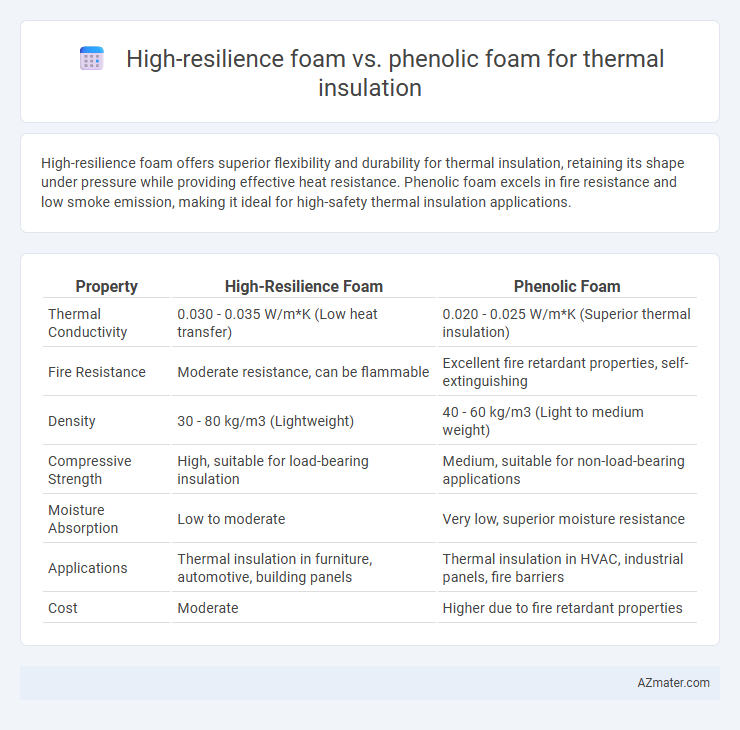High-resilience foam offers superior flexibility and durability for thermal insulation, retaining its shape under pressure while providing effective heat resistance. Phenolic foam excels in fire resistance and low smoke emission, making it ideal for high-safety thermal insulation applications.
Table of Comparison
| Property | High-Resilience Foam | Phenolic Foam |
|---|---|---|
| Thermal Conductivity | 0.030 - 0.035 W/m*K (Low heat transfer) | 0.020 - 0.025 W/m*K (Superior thermal insulation) |
| Fire Resistance | Moderate resistance, can be flammable | Excellent fire retardant properties, self-extinguishing |
| Density | 30 - 80 kg/m3 (Lightweight) | 40 - 60 kg/m3 (Light to medium weight) |
| Compressive Strength | High, suitable for load-bearing insulation | Medium, suitable for non-load-bearing applications |
| Moisture Absorption | Low to moderate | Very low, superior moisture resistance |
| Applications | Thermal insulation in furniture, automotive, building panels | Thermal insulation in HVAC, industrial panels, fire barriers |
| Cost | Moderate | Higher due to fire retardant properties |
Introduction to Thermal Insulation Materials
High-resilience foam offers excellent thermal insulation due to its open-cell structure and superior durability, providing effective temperature regulation and energy efficiency in various applications. Phenolic foam, characterized by its closed-cell composition, delivers exceptional fire resistance and low thermal conductivity, making it ideal for environments requiring stringent safety standards. Both materials are pivotal in modern thermal insulation, with choices depending on specific performance needs such as mechanical strength, thermal stability, and fire safety.
What is High-Resilience Foam?
High-resilience foam is a type of polyurethane foam known for its excellent elasticity, durability, and breathable open-cell structure, making it highly effective for thermal insulation. Its superior mechanical properties enable it to maintain structural integrity and insulation performance under varying temperatures and pressure, contrasting with the more brittle and fire-resistant phenolic foam. High-resilience foam's combination of resilience and thermal resistance provides efficient energy savings and comfort in residential and commercial building applications.
Understanding Phenolic Foam
Phenolic foam offers superior thermal insulation with a low thermal conductivity typically around 0.02 W/m*K, making it highly effective for energy-saving applications. Its closed-cell structure provides excellent fire resistance, low smoke emission, and dimensional stability under high temperatures, outperforming high-resilience foam in harsh environments. Phenolic foam is widely used in industrial and commercial insulation due to its strong chemical resistance and long-term durability.
Key Properties Comparison: High-Resilience vs Phenolic Foam
High-resilience foam offers superior elasticity, enhanced compressive strength, and excellent rebound properties, making it ideal for applications requiring durability and flexibility in thermal insulation. Phenolic foam excels in fire resistance, low smoke emission, and high thermal stability, providing effective insulation with enhanced safety in high-temperature environments. The choice between high-resilience and phenolic foam depends on balancing mechanical performance with fire safety and thermal efficiency in insulation systems.
Thermal Conductivity: Which Insulation Performs Better?
High-resilience foam typically features a thermal conductivity ranging from 0.030 to 0.040 W/m*K, offering effective insulation through its open-cell structure that balances breathability and thermal resistance. Phenolic foam boasts a lower thermal conductivity, generally between 0.020 and 0.025 W/m*K, making it superior in minimizing heat transfer due to its closed-cell, rigid structure with excellent fire resistance. For thermal insulation performance alone, phenolic foam outperforms high-resilience foam by providing better heat retention and energy efficiency in building applications.
Fire Resistance and Safety Aspects
High-resilience foam offers moderate fire resistance but tends to emit toxic gases when burned, posing safety concerns during a fire event. Phenolic foam demonstrates superior fire resistance with a low flame spread index and minimal smoke production, making it a safer choice for thermal insulation in buildings. Its char-forming properties enhance structural integrity under fire conditions, significantly reducing risks to occupants and property.
Durability and Longevity Analysis
High-resilience foam offers superior durability due to its open-cell structure and high rebound resilience, maintaining thermal insulation performance over extended periods without significant degradation. Phenolic foam exhibits excellent fire resistance and low thermal conductivity but may experience brittleness and reduced mechanical strength over time, potentially impacting long-term insulation effectiveness. Comparing longevity, high-resilience foam generally outperforms phenolic foam in maintaining structural integrity under repeated thermal cycling and mechanical stress, making it a preferred choice for applications requiring sustained durability.
Environmental Impact and Sustainability
High-resilience foam and phenolic foam differ significantly in environmental impact and sustainability, with phenolic foam offering superior fire resistance and lower smoke emissions, which contributes to enhanced safety and reduced toxic output during combustion. High-resilience foam, while providing excellent thermal insulation and durability, is typically derived from petrochemical sources and may have higher global warming potential due to its production process and non-biodegradability. Phenolic foam's lower thermal conductivity and potential for recycling align better with sustainable building practices, promoting energy efficiency and reducing the carbon footprint of construction projects.
Cost Efficiency and Installation Considerations
High-resilience foam offers superior flexibility and durability, providing long-term cost efficiency by minimizing maintenance and reducing replacement frequency in thermal insulation applications. Phenolic foam excels in fire resistance and thermal performance but generally incurs higher upfront costs and requires specialized installation techniques, increasing labor expenses. The choice between these materials hinges on balancing initial budget constraints with long-term operational savings and installation complexity.
Choosing the Right Foam for Your Insulation Needs
High-resilience foam offers superior flexibility and durability, making it ideal for applications requiring impact resistance and long-term performance in thermal insulation. Phenolic foam provides excellent fire resistance and low thermal conductivity, which is beneficial for environments demanding stringent fire safety standards and energy efficiency. Choosing the right foam depends on balancing the need for mechanical resilience versus fire safety and insulation effectiveness in your specific project.

Infographic: High-resilience foam vs Phenolic foam for Thermal insulation
 azmater.com
azmater.com